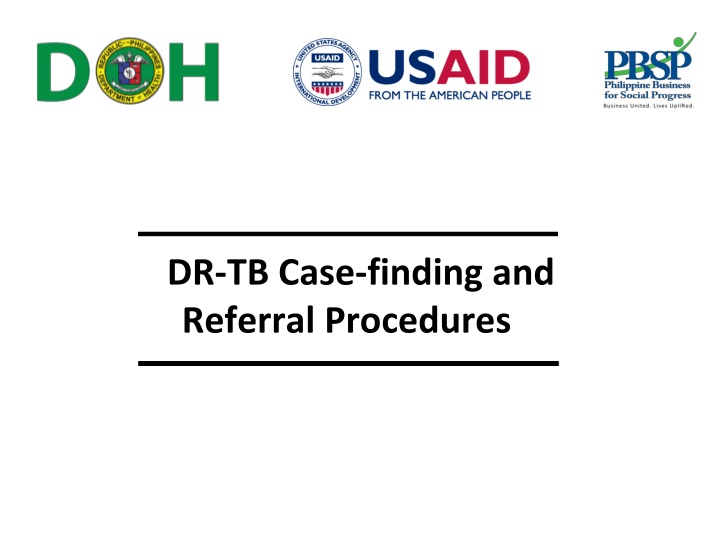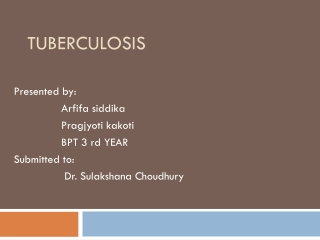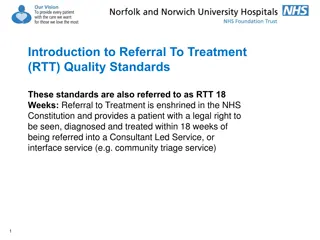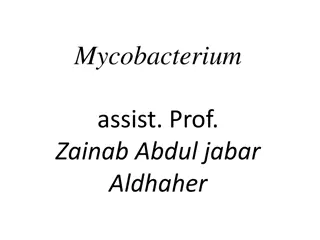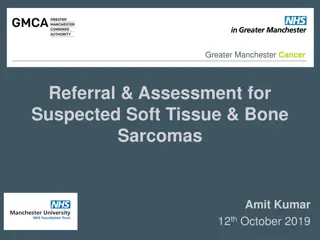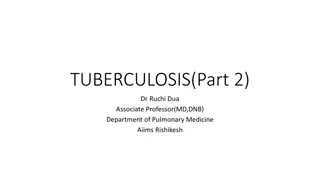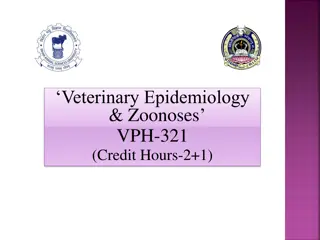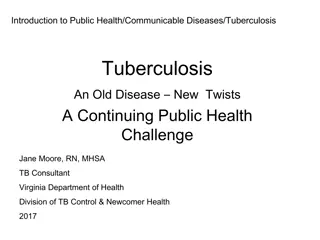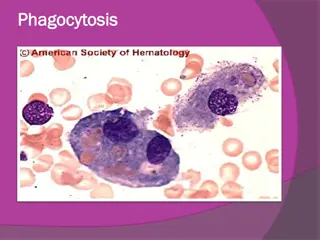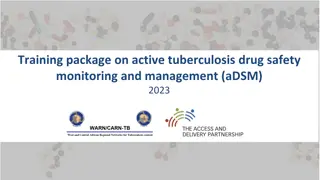Tuberculosis Case Finding and Referral Procedures
This presentation focuses on the identification, referral, and management of presumptive Drug-Resistant Tuberculosis (DR-TB) cases. It covers the roles of health workers, procedures for identifying high-risk groups, collecting specimens for testing, interpreting test results, and referring patients for further care under the Department of Health National TB Control Program.
Download Presentation

Please find below an Image/Link to download the presentation.
The content on the website is provided AS IS for your information and personal use only. It may not be sold, licensed, or shared on other websites without obtaining consent from the author.If you encounter any issues during the download, it is possible that the publisher has removed the file from their server.
You are allowed to download the files provided on this website for personal or commercial use, subject to the condition that they are used lawfully. All files are the property of their respective owners.
The content on the website is provided AS IS for your information and personal use only. It may not be sold, licensed, or shared on other websites without obtaining consent from the author.
E N D
Presentation Transcript
DR-TB Case-finding and Referral Procedures
Objectives At the end of the presentation, the participants will be able to: identify their roles and tasks related to DRTB case finding; identify presumptive TB and DRTB cases; refer presumptive TB and DRTB cases; perform proper collection, handling and storage of quality specimens for Xpert MTB/RIF testing; understand the result of Xpert MTB/RIF testing; and understand the procedures of referring presumptive DRTB Department of Health National TB Control Program
Roles of Public and Private Health Workers in PMDT CASE FINDING 1. Identify presumptive DRTB and refer them to: PMDT facilities (TC/STC/iDOTs using NTP Form 7: Referral Form (public) Referral letter if from private Explain to patients and family what MDRTB means and the framework of management Instruct and encourage patients to submit sputum specimens for Xpert MTB/RIF testing 2. 3. Department of Health National TB Control Program
Case Finding for PMDT IDENTIFICATION OF PRESUMPTIVE DRTB Department of Health National TB Control Program
Presumptive DRTB Presumptive TB (whether adult, adolescent or child) who belongs to any of the DRTB high- risk groups, such as: Retreatment cases New TB cases who are contacts of confirmed DRTB cases or non-converter of Category 1 People living with HIV with signs and symptoms of TB Department of Health National TB Control Program
Groups with High Risk for DRTB RETREATMENT CASES A patient previously treated for TB, who has been declared cured or treatment completed in his/her most recent treatment episode, and is currently diagnosed with bacteriologically confirmed or clinically diagnosed TB A patient who has been previously treated for TB and whose treatment failed at the end of his/her most recent course RELAPSE TREATMENT AFTER FAILURE OR A patient (child or EPTB) for whom sputum examination cannot be done and who did not show clinical improvement anytime during treatment Department of Health National TB Control Program
Groups with High Risk for DRTB RETREATMENT CASES TREATMENT AFTER LOST TO FOLLOW-UP (TALF) A patient who was previously treated for TB but was lost to follow-up for two months or more in his/her most recent course of treatment and is currently diagnosed with either bacteriologically confirmed or clinically diagnosed TB A patient who was previously treated for TB but whose outcome after his/her most recent course of treatment is unknown or undocumented PREVIOUS TREATMENT OUTCOME UNKNOWN OTHERS Patients who do not fit in any of the categories listed above Department of Health National TB Control Program
Groups with High Risk for DRTB NEW CASES NON- CONVERTER OF CATEGORY 1 A patient who is sputum smear positive at the end of the 3rd month of treatment CONTACT OF CONFIRMED MDR-TB CASE A person who shared an enclosed space, such as a house, a social gathering place, workplace or facility, for extended periods within the day with the index case during the 3 months before commencement of the current treatment episode PLHIV WITH SYMPTOMS OF TB People living with HIV with chest X-ray suggestive of TB, or any of the four symptoms: cough, fever, weight loss, night sweats Department of Health National TB Control Program
Exercise Patient SSB, 34 yrs old, who took only 4 months of Category I treatment last year, sought consultation at your health facility. She complains of persistent cough for the last 4 weeks, with back pain, hemoptysis, and weight loss. YES TALF Presumptive DRTB? High-risk group? Department of Health National TB Control Program
Exercise Patient ABN, who had received 3 different courses of TB medications over a period of many years with a private physician, was referred to you by the last physician who treated her because her recent CXR result was suggestive of TB. According to her records, she took all of the medicines and completed each prescribed treatment. YES RELAPSE Presumptive DR-TB? High-risk group? Department of Health National TB Control Program
Exercise Patient GGG, a DRTB patient currently undergoing treatment, brought his 6-year-old son to your facility. The child has been experiencing cough for one week. The child has no history of any TB treatment and could not yet expectorate. YES CONTACT OF A CONFIRMED DRTB CASE Presumptive DRTB? High-risk group? Department of Health National TB Control Program
Exercise Patient SNM, a 17-year-old female student, has come to your treatment facility for cough of more than two weeks and fever of five days. She has never been diagnosed or treated for TB in the past. She is unaware of any exposure to anyone with TB in the home or in school. You examined her and she has rales on both lower lung fields. NO, presumptive DSTB only N/A Presumptive DRTB? High-risk group? Department of Health National TB Control Program
Exercise Patient JGS, 18 years old, who is being treated for HIV in one of the treatment hubs in Metro Manila, has been experiencing cough for 7 days already. She has no previous anti-TB treatment. YES PLHIV with signs and symptoms suggestive of TB DRTB suspect? High-risk group? Department of Health National TB Control Program
Exercise Patient RRH is currently on Category 2 treatment (Relapse). His Xpert result prior to starting treatment was: MTB detected, Rif resistance not detected. After 3 months of intensive phase (2HRZES/1HRZE), his follow-up DSSM was 1+. YES NON-CONVERTER OF CAT II Presumptive DRTB? High-risk group? Department of Health National TB Control Program
Case-finding Procedure for PMDT Facility without PMDT Services PMDT Facility Rifampicin resistant Xpert MTB/RIF Test Bacteriologically confirmed RR-TB Identification and referral of Presumptive DRTB Screening, assessment, sputum collection Department of Health National TB Control Program
Case-finding Procedure for PMDT Facility with or without PMDT services PMDT Facility Rifampicin resistant Identification and referral of presumptive DRTB Bacteriologically confirmed RR-TB Xpert MTB/RIF Test Treatment Screening, sputum collection Department of Health National TB Control Program
PMDT Treatment Facilities and Rapid TB Diagnostic Laboratories in the Region Provide the following in this slide: Name and picture of PMDT treatment facility(ies) and rapid TB diagnostic laboratories (RTDLs) in the Region Operating hours or schedule for receiving referrals Complete Address Contact Information Name of PMDT treatment facility head/physician Department of Health National TB Control Program
PROCEDURES FOR REFERRING PRESUMPTIVE DRTB Department of Health National TB Control Program
Referring Presumptive DRTB Option 1: Presumptive DRTB identified can be referred directly to the PMDT treatment facility for diagnosis and treatment Step 2 Step 3 Step 1 TS, DOTS facilities, PPMDs, hospitals, clinics 1. Assess identified Presumptive DRTB. 2. Accomplish Form 7. NTP Referral Form. 3. Instruct patient to report to the PMDT facility. PMDT Facility Department of Health National TB Control Program
Ensure COMPLETENESS and CORRECTNESS of information!!! Please attach copy of: 1. NTP treatment card/s of previous treatment/s 2. Latest DSSM results 3. Other laboratory results (CXR, TBDC, blood chemistry)
Referring Presumptive DRTB Option 2: Request for Xpert test directly at Xpert site (if with access) and refer confirmed RR-TB to PMDT treatment facility Step 1 Step 3 Step 2 MTB detected, Rifampicin resistance detected Bacteriologically confirmed RR-TB TS, DOTS facilities, PPMDs, hospitals, clinics Xpert Site 1. Assess identified presumptive DRTB, collect sputum specimen, and fill out Form 2a. NTP Laboratory Request Form. 2. Send collected specimen and request form to Xpert site. 3. Fill out Form 7. NTP Referral Form and refer confirmed RR-TB case to the PMDT facility (with the DSSM and Xpert results). PMDT Facility Department of Health National TB Control Program
Referring Presumptive DRTB Option 3: Send accomplished PMDT documents and collected specimen Step 3 Step 1 Step 2 MTB detected, Rifampicin resistance detected courier TS, DOTS facilities, PPMDs, hospitals, clinics 1. Assess identified presumptive DRTB and fill up the DRTB Screening Form and Suspects Referral Form. 2. Collect 1 sputum specimen (preferably early morning specimen). 3. Send documents and collected specimen to the PMDT facility via courier. PMDT Facility Department of Health National TB Control Program
Referring Presumptive DRTB Option 4: Send accomplished laboratory request form and collected specimen Step 3 Step 1 Step 2 MTB detected, Rifampicin resistance detected courier TS, DOTS facilities, PPMDs, hospitals, clinics RTDL 1. Assess identified presumptive DRTB and fill-up the DRTB Screening Form and Suspects Referral Form. 2. Collect 1 sputum specimen (preferably early morning specimen). 3. Send documents and collected specimen to RTDL via courier. Department of Health National TB Control Program
Sputum Collection for Xpert MTB/RIF Test Usewide-mouthed sputum cup or 50 ml conical tube Label the body of the sputum cup/ conical tube, indicating patient s complete name and that specimen is for Xpert MTB/RIF test Department of Health National TB Control Program
Amount and Quality of Specimen for Xpert MTB/RIF Test Only ONE specimen (> 1ml) Solid or purulent particles, coughed out deeply from the lungs Non-salivary No food particles Not blood stained Department of Health National TB Control Program
Storage of Specimen If the sputum cannot be processed immediately, the specimen can be stored: 35 C maximum of 3 days 4 C maximum of <10 days Department of Health National TB Control Program
